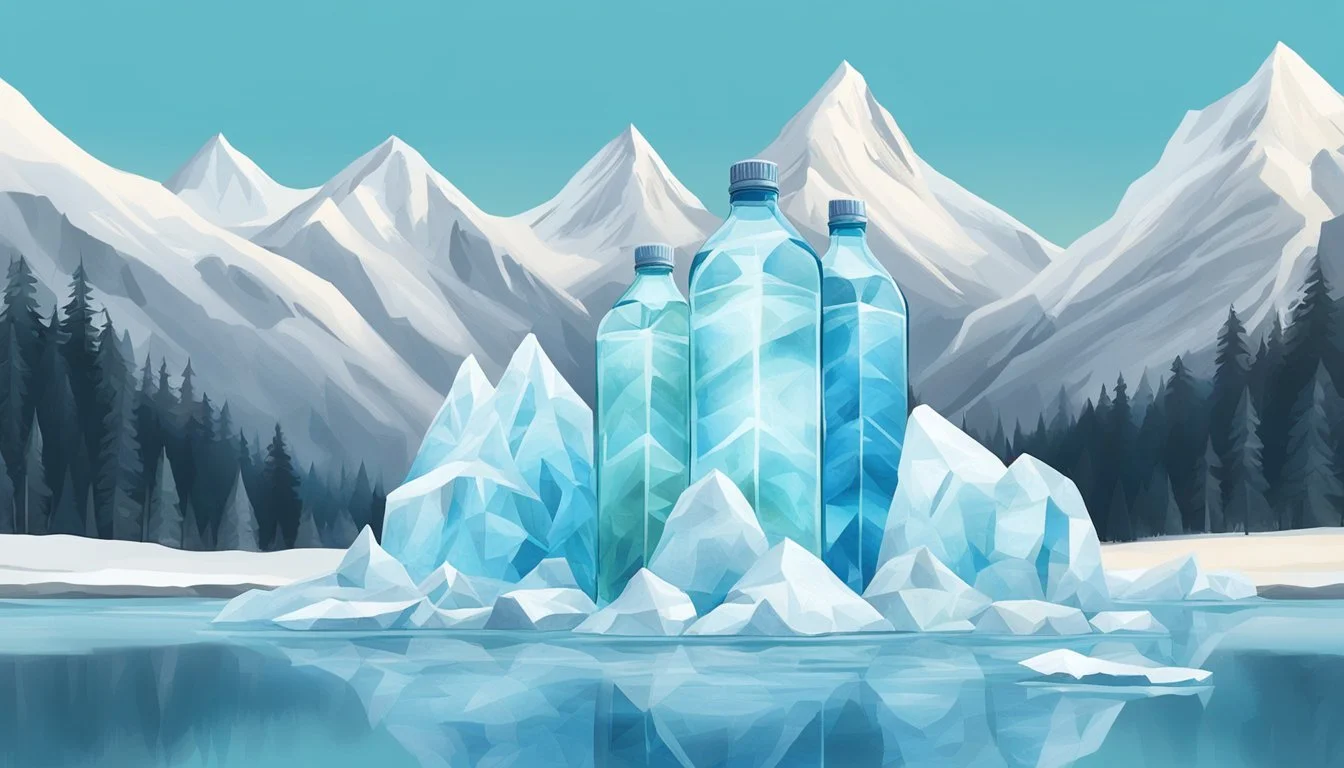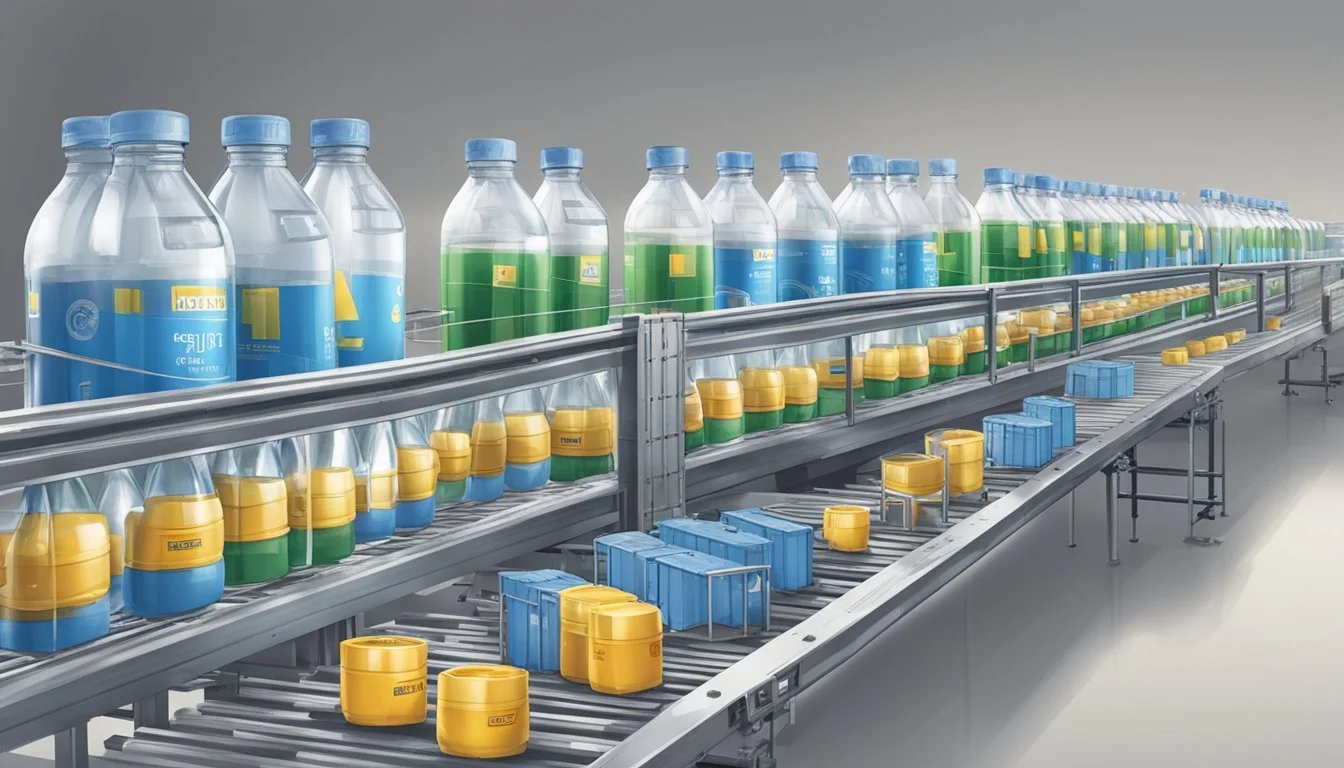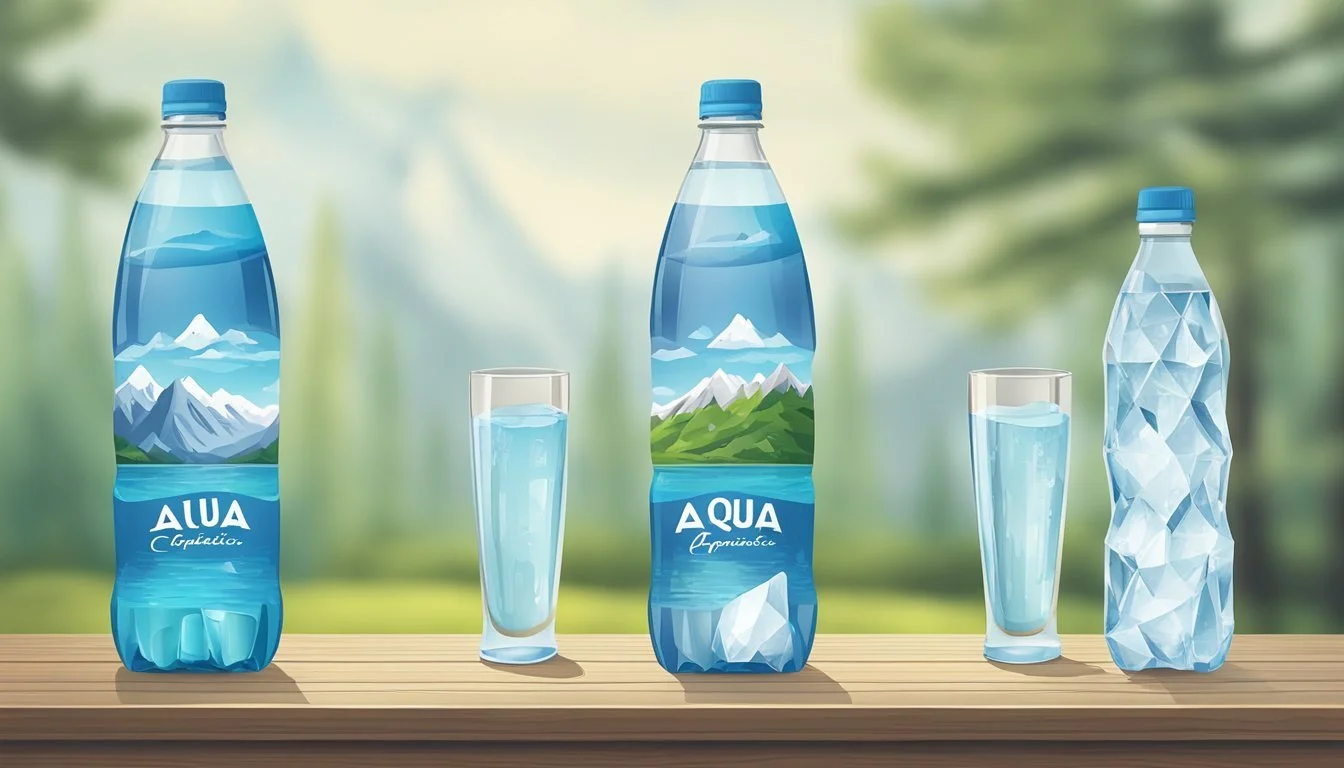Ice Mountain vs. Aqua Carpatica
Comparing Quality and Taste
For consumers seeking the best bottled water, the choice between Ice Mountain and Aqua Carpatica often comes down to personal preference and specific hydration needs. Ice Mountain, known for its multi-step filtration process, offers a refreshing taste and is sourced from natural springs in Michigan. Its reputation for quality makes it a popular choice among bottled water enthusiasts.
Aqua Carpatica, sourced from the Carpathian Mountains, boasts naturally occurring electrolytes and low sodium content, which can be appealing for those looking for a purer hydration experience. This brand positions itself as a premium choice with unique health benefits tied to its natural mineral composition.
When comparing Ice Mountain and Aqua Carpatica, Aqua Carpatica stands out for its higher mineral content and health benefits. The decision ultimately depends on what consumers value more in their bottled water — the trusted quality of Ice Mountain or the unique purity and benefits of Aqua Carpatica.
Understanding Bottled Water
Bottled water plays a significant role in daily hydration, providing a convenient and consistent source of water. It's available in various types, catering to different tastes and nutritional needs.
Definition and Importance of Hydration
Hydration is vital for maintaining numerous bodily functions including regulating temperature, lubricating joints, and aiding digestion. Bottled water offers an accessible means to ensure adequate daily water intake.
Proper hydration supports cardiovascular health, cognitive functions, and muscular performance. Dehydration, on the other hand, can lead to fatigue, dizziness, and more severe health issues if not addressed promptly.
Types of Bottled Water
Spring Water: Sourced from natural springs, it retains minerals naturally present in the water.
Purified Water: Undergoes rigorous filtration processes like reverse osmosis to remove impurities and contaminants.
Mineral Water: Contains specific amounts of minerals added or naturally present, beneficial for certain health aspects.
These types are chosen based on personal preference for taste, mineral content, and intended health benefits.
Bottled Water Brands Overview
Several brands dominate the bottled water market, each offering unique products to cater to varying consumer preferences.
Examples include Ice Mountain, known for its multi-step filtration process, and Aqua Carpatica, appreciated for its low nitrate content and rich mineral profile. Brands differ in their source water, mineral addition, and packaging, influencing consumer choices. Identifying a preference often involves sampling different brands and understanding their unique characteristics.
Comparing Ice Mountain and Aqua Carpatica
This section discusses the origins, water sources and quality, taste profile, consumer preference, and nutritional and mineral content of Ice Mountain and Aqua Carpatica bottled waters. Each brand offers unique characteristics that cater to different consumer needs.
Brand Origins
Ice Mountain is a well-recognized brand in North America, particularly in the Midwest. Established in 1987, it has built a reputation for delivering refreshing spring water. The brand is part of the BlueTriton Brands portfolio.
Aqua Carpatica, on the other hand, originates from Romania. Specifically, it comes from the Carpathian Mountains, an area known for its pristine natural environment. Aqua Carpatica markets itself as a premium, naturally sparkling mineral water.
Water Sources and Quality
Ice Mountain sources its water from natural springs located in Michigan. The water is known for its clean and crisp quality, adhering to strict safety and purification standards to ensure consumer trust.
Aqua Carpatica sources its water from the Carpathian Mountains' natural springs. The water is naturally carbonated, meaning it requires minimal processing. The brand emphasizes its low sodium content and lack of nitrates, appealing to health-conscious consumers.
Taste Profile and Consumer Preference
Ice Mountain offers a smooth and refreshing taste, with a neutral pH level that appeals to a wide array of consumers. It is particularly favored for its clean taste without any aftertaste, making it ideal for everyday hydration.
Aqua Carpatica is known for its unique taste, which comes from its natural mineral content. The water is naturally sparkling, offering a distinct effervescence that sets it apart from other brands. Its taste is often described as rich and mineral-heavy, catering to those who prefer a strong, natural flavor.
Nutritional and Mineral Content
Ice Mountain water contains essential minerals like calcium and magnesium in small quantities. The mineral content is balanced to provide a refreshing drink without overwhelming the palate. It is suitable for those looking for a simple, hydrating option.
Aqua Carpatica boasts a higher mineral content, including significant levels of calcium and magnesium. The brand highlights its naturally low sodium levels and absence of nitrates, making it a healthier choice for those monitoring their mineral intake.
Production and Packaging Processes
When comparing Ice Mountain and Aqua Carpatica, it is crucial to focus on their production and packaging processes. These aspects directly influence the quality and environmental impact of the bottled water.
Filtration and Purification
Ice Mountain utilizes a rigorous multi-step filtration process. This includes initial screening to remove large particles, followed by processes like activated carbon filtration and ozonation. Their approach ensures high purity levels, targeting any potential contaminants.
Aqua Carpatica, sourced from the Carpathian Mountains, emphasizes natural purity. The water undergoes minimal processing, maintaining its natural mineral content. The primary method is microfiltration, which retains beneficial minerals while ensuring microbial safety.
Bottling and Packaging Materials
Ice Mountain typically employs 100% plastic bottles. These bottles are often made from recycled plastic, aligning with eco-friendly practices, although they are mostly derived from petrochemicals. The plastic is BPA-free, addressing health concerns related to chemical leaching.
Aqua Carpatica offers both glass and plastic bottles. Their glass bottles, fully recyclable, are favored for premium products, while their plastic bottles also use BPA-free materials. This dual approach balances aesthetic appeal and practicality. Aqua Carpatica's packaging highlights its commitment to reducing environmental impact through sustainable materials.
Health and Ecological Impacts
Understanding the health benefits and ecological consequences of bottled water brands such as Ice Mountain and Aqua Carpatica is essential for consumers who prioritize both personal well-being and environmental responsibility.
Essential Electrolytes for Hydration
Electrolytes like potassium, sodium, and magnesium are vital for maintaining proper hydration and bodily functions. Aqua Carpatica contains natural electrolytes sourced from mineral springs, which can help with muscle function and hydration. Ice Mountain, known for its crisp taste, also provides necessary electrolytes, though the mineral content may vary due to differing sources. Both brands aim to offer refreshed alternatives to tap water, which might lack these key minerals or add them artificially. Consuming bottled water with natural electrolytes can be beneficial, especially for active individuals or those with specific dietary needs.
Potential Contaminants in Bottled Water
Bottled water purity is a significant concern for many. Both brands adhere to strict safety standards to minimize contaminants such as PFAS chemicals and heavy metals. Aqua Carpatica prides itself on low nitrate levels and regularly tests for pollutants to ensure high-quality water. Ice Mountain undergoes rigorous testing to comply with federal regulations and reduce the risk of contaminants. Consumers also often compare this to municipal water, which can vary in quality and may contain additives like chlorine. Choosing a reputable bottled water reduces the potential risk of ingesting harmful substances often found in less-regulated tap water sources.
Sustainability Efforts by Companies
Environmental impact is a critical aspect of evaluating bottled water brands. Ice Mountain utilizes 100% recyclable plastic bottles, though the recycling rate remains relatively low. They are also exploring initiatives to reduce plastic usage. Aqua Carpatica uses eco-friendly packaging and has invested in sustainable practices such as reducing the carbon footprint of their operations. This involves sourcing water responsibly and implementing energy-efficient bottling processes. By prioritizing sustainability, both companies aim to mitigate the ecological footprint associated with bottled water production, offering consumers choices that align better with environmental values. This commitment is crucial as bottled water production has a higher environmental impact compared to tap water.
Market Analysis
The battle between Ice Mountain and Aqua Carpatica extends beyond taste to encompass consumer preferences, brand comparisons, and value for money. Understanding these dynamics provides valuable insight into the market.
Consumer Demand and Preferences
Consumers show a distinct preference for specific bottled water brands based on taste, packaging, and brand loyalty. Ice Mountain, backed by Nestlé, is favored for its regional availability and competitive pricing.
Aqua Carpatica appeals to a niche market focused on high-quality, mineral-rich water. Their packaging is seen as sophisticated, reinforcing a premium image.
Survey data often highlight convenience and accessibility as significant factors influencing consumer choice. Both brands capitalize on these factors by maintaining a strong presence in retail outlets, including major chains like Amazon and Starbucks.
Comparison to Other Bottled Water Brands
Ice Mountain and Aqua Carpatica face competition from other established brands such as Smartwater, Fiji, Voss, Evian, Dasani, and Aquafina. Each brand targets distinct market segments.
Smartwater emphasizes purity and vapor-distilled processes, appealing to fitness enthusiasts.
Fiji and Evian pride themselves on natural artesian and spring water sources, gathering a loyal following.
Voss is synonymous with luxury, often found in high-end hotels and restaurants.
Aquafina and Dasani dominate the market through widespread availability and aggressive marketing by parent companies PepsiCo and Coca-Cola, respectively.
Ice Mountain and Aqua Carpatica differentiate themselves through unique selling points, such as regional sourcing and mineral content.
Price and Value for Money
Ice Mountain is often positioned as a budget-friendly option, accessible to a wide range of consumers. Prices are kept low due to mass production and efficient distribution networks managed by Nestlé.
Aqua Carpatica is priced higher, reflecting its premium status and mineral content. It is marketed as a high-end product, targeting consumers willing to pay more for perceived health benefits and superior quality.
When evaluating value for money, consumers weigh factors like taste, health benefits, and packaging. Ice Mountain offers convenience and affordability, while Aqua Carpatica provides superior mineral content at a higher price, catering to niche preferences.
Legal and Regulatory Perspectives
This section covers the standards and regulations governing bottled water, with a focus on the role of the Environmental Protection Agency (EPA) in maintaining quality and safety.
Bottled Water Standards and Regulations
Bottled water, including brands like Ice Mountain and Aqua Carpatica, must comply with stringent standards set by regulatory agencies. The Food and Drug Administration (FDA) oversees bottled water regulations in the United States. These mandates include requirements for labeling, quality, and good manufacturing practices.
Standards: Bottled water must meet specific microbial, physical, chemical, and radiological safety standards. These encompass maximum contaminant levels for substances like lead, arsenic, and E.coli. The FDA periodically updates these standards to incorporate the latest scientific findings.
Quality: Both Ice Mountain and Aqua Carpatica undergo rigorous purification processes, involving steps like filtration, UV light treatment, and ozonation. These processes aim to eliminate contaminants and ensure the water is safe for consumption.
Role of Environmental Protection Agency
The Environmental Protection Agency (EPA) plays a significant role in regulating tap water, which serves as a baseline comparison for bottled water standards. While the EPA doesn't directly regulate bottled water, its guidelines for drinking water quality influence FDA policies.
Regulations: The EPA regulates contaminants like microplastics and chemical residues in water. Recent studies, including those focused on Ice Mountain, highlight concerns about microplastic contamination, driving more stringent monitoring and regulatory actions.
Standards: The EPA sets limits for over 90 contaminants in public water systems, including lead and chlorine. These standards affect the quality benchmarks used by the FDA for bottled water. Both Ice Mountain and Aqua Carpatica must adhere to these derived standards to ensure consumer safety.
Alternatives to Bottled Water
Individuals seeking environmentally friendly and cost-effective options usually turn to alternatives like tap water, advanced filtration systems, and reusable bottles as sustainable practices. These offer practical and efficient solutions to reduce dependency on bottled water.
Tap and Municipal Water Solutions
Tap water, when properly treated, can be a reliable alternative to bottled water. Many municipalities adhere to strict regulations to ensure water safety and quality.
People often install in-home filtration systems like activated carbon filters to improve taste and remove contaminants. Public awareness campaigns about the benefits of tap water, such as reduced cost and decreased plastic waste, have been effective in encouraging its use.
Technological Advances in Filtration Systems
Modern filtration systems have advanced significantly, providing high-quality water at home. Reverse osmosis units, for instance, use a semipermeable membrane to remove impurities.
Point-of-use filters, such as countertop or under-sink models, can also offer effective purification. These technologies help eliminate common contaminants, including heavy metals and chlorine, ensuring clean and safe drinking water.
Reusable Bottles and Sustainable Practices
Reusable bottles made from materials like stainless steel or glass present a durable and eco-friendly alternative to single-use plastic bottles. Consumers are increasingly adopting these options, reducing plastic waste and promoting sustainability.
Brands now offer a variety of stylish and functional designs, making it easy to carry and refill water on the go. Engaging in these sustainable practices not only benefits the environment but also supports a shift towards more responsible consumption habits.
Conclusion
Ice Mountain and Aqua Carpatica offer distinct options for bottled water consumers.
In taste tests, Aqua Carpatica is often praised for its crisp and clean flavor, while Ice Mountain is known for its smooth and slightly sweet taste.
When considering overall quality, Ice Mountain leverages a multi-step filtration process, ensuring purity and consistency. Meanwhile, Aqua Carpatica boasts naturally occurring electrolytes and a low mineral content.
Health and hydration are critical factors. Both brands are free from harmful chemicals, but Aqua Carpatica's nitrate-free guarantee adds an extra layer of consumer confidence.
Environmental impact plays a significant role in consumer choice. Ice Mountain's use of 100% recycled plastic (rPET) for its bottles shows a commitment to sustainability. Aqua Carpatica emphasizes natural sourcing and eco-friendly practices in their production process.
Ultimately, consumer preferences for either brand will hinge on individual priorities regarding taste, quality, health benefits, and environmental considerations.
More About Ice Mountain
Core Hydration vs Ice Mountain: Which Bottled Water is Better?
Ice Mountain vs Cascade Mountain: Which Bottled Water is Better?
Ice Mountain vs Crystal Geyser: Which Bottled Water is Better?
Ice Mountain vs Crystal Lake: Which Bottled Water is Better?
Ice Mountain vs Essence pH10: Which Bottled Water is Better?
Ice Mountain vs Hawaii Volcanic: Which Bottled Water is Better?
Ice Mountain vs Hawaiian Springs: Which Bottled Water is Better?
Ice Mountain vs Icelandic Glacial: Which Bottled Water is Better?
Ice Mountain vs Kirkland Signature: Which Bottled Water is Better?
Ice Mountain vs Liquid Death: Which Bottled Water is Better?
Ice Mountain vs Mountain Valley Spring Water: Which Bottled Water is Better?
Ice Mountain vs Nestle Pure Life: Which Bottled Water is Better?
Ice Mountain vs Poland Spring: Which Bottled Water is Better?
Ice Mountain vs Proud Source: Which Bottled Water is Better?
Ice Mountain vs Purely Sedona: Which Bottled Water is Better?
Ice Mountain vs Richard's Rainwater: Which Bottled Water is Better?
Ice Mountain vs San Pellegrino: Which Bottled Water is Better?
Ice Mountain vs Simple Truth: Which Bottled Water is Better?
Ice Mountain vs Solan de Cabras: Which Bottled Water is Better?
Ice Mountain vs Talking Rain AQA: Which Bottled Water is Better?
Ice Mountain vs Whole Foods 365: Which Bottled Water is Better?
Ice Mountain vs Whole Foods Italian Still Mineral water: Which Bottled Water is Better?
More About Aqua Carpatica
Acqua Pana vs Aqua Carpatica: Which Bottled Water is Better?
Aqua Carpatica vs Alkaline88: Which Bottled Water is Better?
Aqua Carpatica vs Cascade Mountain: Which Bottled Water is Better?
Aqua Carpatica vs Castle Rock: Which Bottled Water is Better?
Aqua Carpatica vs CBD Living: Which Bottled Water is Better?
Aqua Carpatica vs Crystal Geyser: Which Bottled Water is Better?
Aqua Carpatica vs Crystal Lake: Which Bottled Water is Better?
Aqua Carpatica vs Essence pH10: Which Bottled Water is Better?
Aqua Carpatica vs Hawaii Volcanic: Which Bottled Water is Better?
Aqua Carpatica vs Hawaiian Springs: Which Bottled Water is Better?
Aqua Carpatica vs Kirkland Signature: Which Bottled Water is Better?
Aqua Carpatica vs Liquid Death: Which Bottled Water is Better?
Aqua Carpatica vs Open Water: Which Bottled Water is Better?
Aqua Carpatica vs Proud Source: Which Bottled Water is Better?
Aqua Carpatica vs Purely Sedona: Which Bottled Water is Better?
Aqua Carpatica vs Richard's Rainwater: Which Bottled Water is Better?
Aqua Carpatica vs Simple Truth: Which Bottled Water is Better?
Aqua Carpatica vs Solan de Cabras: Which Bottled Water is Better?
Aqua Carpatica vs Talking Rain AQA: Which Bottled Water is Better?
Aqua Carpatica vs Weird Water: Which Bottled Water is Better?
Aqua Carpatica vs Whole Foods 365: Which Bottled Water is Better?
Aqua Carpatica vs Whole Foods Italian Still Mineral water: Which Bottled Water is Better?
Boxed Water vs Aqua Carpatica: Which Bottled Water is Better?
Core Hydration vs Aqua Carpatica: Which Bottled Water is Better?
Icelandic Glacial vs Aqua Carpatica: Which Bottled Water is Better?
Just Water vs Aqua Carpatica: Which Bottled Water is Better?
Mountain Valley Spring Water vs Aqua Carpatica: Which Bottled Water is Better?
Nestle Pure Life vs Aqua Carpatica: Which Bottled Water is Better?
Poland Spring vs Aqua Carpatica: Which Bottled Water is Better?
San Pellegrino vs Aqua Carpatica: Which Bottled Water is Better?
Smartwater vs Aqua Carpatica: Which Bottled Water is Better?
Topo Chico vs Aqua Carpatica: Which Bottled Water is Better?
Zephyrhills vs Aqua Carpatica: Which Bottled Water is Better?







